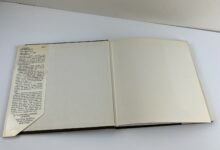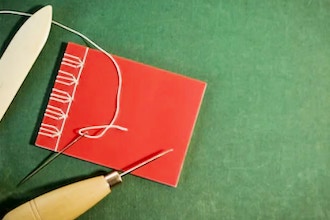Bookbinding for Scrapbookers: Techniques to Preserve Memories in Style
Contents
- 1 An Introduction to Bookbinding for Scrapbookers
- 2 The Strengths of Bookbinding for Scrapbookers
- 3 The Weaknesses of Bookbinding for Scrapbookers
- 4 A Table Overview of Bookbinding for Scrapbookers
- 5 Frequently Asked Questions
- 5.1 1. What materials do I need for bookbinding?
- 5.2 2. Can I use scrapbook papers for bookbinding?
- 5.3 3. How long does it take to bind a book?
- 5.4 4. Can I bind my existing scrapbook pages into a book?
- 5.5 5. Are there any online resources or tutorials for learning bookbinding?
- 5.6 6. Can I personalize the cover of my bound scrapbook?
- 5.7 7. How do I ensure the longevity of my bound scrapbook?
- 6 Conclusion: Preserving Memories with Style
An Introduction to Bookbinding for Scrapbookers
Hello Readers! Welcome to an exciting journey into the world of bookbinding for scrapbookers. In this article, we will explore various techniques that allow you to preserve your cherished memories in a unique and stylish manner. Whether you are a beginner or an experienced scrapbooker, bookbinding can add a whole new dimension to your creative process.
Bookbinding is an age-old craft that involves assembling and binding pages together to create a book. When applied to scrapbooking, this technique enables you to combine photographs, memorabilia, and journaling in beautifully bound albums, making your memories more tangible and enduring.
In this comprehensive guide, we will delve into the strengths and weaknesses of bookbinding for scrapbookers, discuss various techniques you can employ, and provide step-by-step instructions to help you get started. Additionally, we will answer some frequently asked questions regarding this art form. So, let’s dive in and explore the world of bookbinding for scrapbookers!
The Strengths of Bookbinding for Scrapbookers
1. Creativity Unleashed:
Bookbinding offers the perfect avenue for scrapbookers to unleash their creativity. With endless possibilities in terms of materials, styles, and design elements, you can truly express yourself and create unique books that reflect your personal style and memories.
2. Longevity and Durability:
One of the major advantages of bookbinding is the durability it provides to your scrapbooks. Properly bound books can withstand the test of time, ensuring that your precious memories are preserved intact for generations to come.
3. Customizability:
When you choose to bind your own scrapbooks, you have complete control over the layout, size, and structure of the pages. This allows you to tailor your books to suit the specific theme or occasion, resulting in personalized and meaningful creations.
4. Enhanced Protection:
Bookbinding provides an additional layer of protection to your scrapbook pages. Bound albums help safeguard your photographs and memorabilia from dust, moisture, and other external elements, ensuring their longevity and quality.
5. Variety of Techniques:
There are numerous bookbinding techniques that you can experiment with as a scrapbooker. From Japanese stab binding to coptic stitching, each technique offers its own visual appeal and unique characteristics, allowing you to explore different artistic possibilities.
6. Sense of Achievement:
Creating a book from scratch is an incredibly satisfying experience. As you learn and master different bookbinding techniques, you will gain a sense of accomplishment, knowing that you have not only preserved your memories but also crafted a handmade piece of art.
7. Versatility:
Bookbinding for scrapbookers is versatile in terms of the types of materials you can use. Whether you prefer using traditional papers, fabric, or even unconventional materials like wood or metal, there are various options to experiment with and create truly unique scrapbooks.
The Weaknesses of Bookbinding for Scrapbookers
1. Time-consuming Process:
Bookbinding can be a time-consuming process, especially if you are new to the craft. From selecting materials to binding the pages together, each step requires careful attention and patience. However, the end result is worth the effort.
2. Skill Development:
Mastering bookbinding techniques takes time and practice. As a beginner, you may experience a learning curve, and it may take several attempts before you achieve the desired results. However, with dedication and perseverance, you can develop the necessary skills.
3. Cost Considerations:
While bookbinding can be a cost-effective option in the long run, there are initial expenses associated with purchasing materials and tools. Depending on your preferred techniques and materials, the cost of bookbinding for scrapbooking can vary.
4. Limited Page Capacity:
Depending on the binding technique you choose, there may be limitations on the number of pages you can include in a single book. This can be challenging if you have a large number of photos and memorabilia that you wish to include in a single album.
5. Precision and Attention to Detail:
Bookbinding requires precision and attention to detail to ensure that the pages align correctly and the binding is secure. This can be daunting for those who prefer a more casual or spontaneous approach to scrapbooking.
6. Accessibility of Materials:
Not all materials required for bookbinding may be readily available in your local craft store or region. You may need to order specialized materials or explore alternative options, which can add complexity to the process.
7. Limited Portability:
While bound scrapbooks offer superior protection, they can be less portable compared to loose-leaf albums. Depending on the size and design of your book, it may be challenging to carry it around or share it with others on-the-go.
A Table Overview of Bookbinding for Scrapbookers
| Binding Technique | Description |
|---|---|
| Japanese Stab Binding | A traditional method involving the use of decorative stitches to bind the pages together. |
| Coptic Stitching | An ancient technique characterized by exposed stitches on the spine and flexibility in opening the book flat. |
| Long Stitch Binding | Involves sewing through the entire length of the spine, creating a distinctive exposed stitch pattern. |
| Accordion Fold Binding | Accordion-style folding of pages, allowing for an interactive and visually appealing layout. |
| Pamphlet Stitch Binding | A simple and versatile technique commonly used for binding small or thin books. |
| Perfect Binding | A professional-looking binding method commonly used in commercially produced books. |
| Post Binding | Uses posts and screws to secure the pages, allowing for easy addition or removal of pages. |
Frequently Asked Questions
1. What materials do I need for bookbinding?
Bookbinding materials may include binding boards, bookbinding glue, decorative papers, thread, bookbinding needles, and cutting tools.
2. Can I use scrapbook papers for bookbinding?
Yes, scrapbook papers can be used for bookbinding. They offer a wide range of designs and patterns that can enhance the visual appeal of your book.
3. How long does it take to bind a book?
The time required to bind a book depends on the complexity of the chosen technique and your level of expertise. It can range from a few hours to several days.
4. Can I bind my existing scrapbook pages into a book?
Yes, you can bind your existing scrapbook pages into a book using various bookbinding techniques. This allows you to transform loose pages into a cohesive and professionally bound album.
5. Are there any online resources or tutorials for learning bookbinding?
Yes, there are numerous online resources and tutorials available that provide step-by-step instructions, video demonstrations, and tips for learning different bookbinding techniques.
6. Can I personalize the cover of my bound scrapbook?
Absolutely! Personalizing the cover of your bound scrapbook is a great way to make it unique. You can use decorative papers, photographs, fabrics, or even hand-lettering to add a personal touch.
7. How do I ensure the longevity of my bound scrapbook?
To ensure the longevity of your bound scrapbook, store it in a cool and dry place away from direct sunlight. Avoid exposing it to moisture and handle it with clean hands to prevent oil or dirt transfer.
Conclusion: Preserving Memories with Style
In conclusion, bookbinding for scrapbookers offers a multitude of creative possibilities and advantages. From unleashing your creativity to protecting your memories, this craft allows you to preserve your cherished moments in style. With a variety of techniques to explore and personalize, you can create unique bound books that truly reflect your individuality.
While bookbinding may require time, patience, and investment, the sense of achievement and the enduring beauty of your handcrafted books make it all worthwhile. So, don’t hesitate to embark on this exciting journey of bookbinding for scrapbookers and elevate your scrapbooking experience to new heights!
Remember, the memories you preserve today can be treasured and shared for generations to come. Start bookbinding and create your own legacy of memories in style.
Disclaimer: The information provided in this article is for informational purposes only. The author and publisher do not assume any liability for any actions or outcomes resulting from the use of this information.
Originally posted 2023-09-03 15:27:37.









